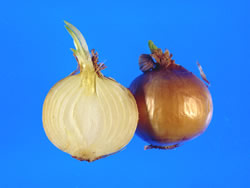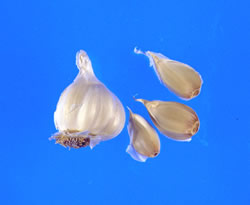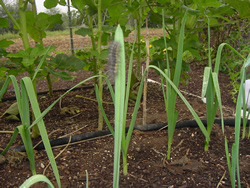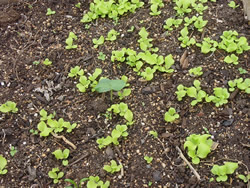
Search
For The Answer
Click here to access our database of
Plant Answers
Search
For The Picture
Click here to access the Google database of plants
and insects
Information
Index
Alphabetical Listing of Topics, Recommendations
and Plants
- Turf Grass & Sod
- Milton Glueck, Host of Milberger's Gardening Show
- Arcadia
Archives -
Greg Grant - Friends of PLANT Answers
Milberger's Nursery and Landscaping
3920 North Loop 1604 E.
San Antonio, TX 78247
210.497.3760
nursery@milbergersa.com
Open 9 to 6 Mon. through Sat.
and 10 to 5 on Sun.

Three exits east of 281, inside of 1604
Next to the Diamond Shamrock station
Please click map for more detailed map and driving directions.
ONIONS, GARLIC AND CRAWFORD LETTUCE
Yesterday was October 15 which should be proclaimed a Texas holiday. It is the designated birthday of the Texas State Vegetable since 1997 which is the Texas sweet onion-the most famous of which is the 1015Y. Saying that October 15 is the birthday is a bit misleading - October 15 is when seed should be planted so the actual "birth" of the seedling occurs when sprouting begins. Since onions are such a big part of Mexican food, I thought we should name the holiday Octubre quince Y to go along with Cinco die Mayo (May 5), Cieci Seis (Sept. 16) and Dia de los Muertos.
It should also be recognized that there were other onion selections named after October and even November planting dates. According to the history of Texas onions at: http://aggie-horticulture.tamu.edu/plantanswers/publications/onions/onionhis.html "The pink root (a fungus disease which kills the root system)
screening block was developed at the Weslaco, Texas, Station so
that Paul Leeper and Leonard Pike could develop pink root resistance
in their new varieties. From a planting of the onion variety Texas
Early Grano 951, the yellow (Y) selections of Texas Grano 1015Y,
Texas Grano 1020Y, Texas Grano 1025Y, Texas Grano 1030Y, and Texas
Grano 1105Y were made from the pink root block." The 1015Y
became the most popular because of its mild flavor and low pungency.
Flowering of onions can be caused by several things, but usually the most prevalent reason is temperature fluctuation. An onion is classed as a biennial, which means it normally takes 2 years to go from seed to seed. Temperature is the controlling or triggering factor in this process. If an onion plant is exposed to alternating cold and warm temperatures, the result is the onion plant going dormant, then resuming growth, then going dormant and resuming growth again. The onion bulbs prematurely flower or bolt. The onion is deceived into believing it has completed 2 growth cycles, or years of growth in its biennial life cycle so it finalizes the cycle by blooming. Flowering can be controlled by planting the right variety at the right time. Use only transplants that are pencil-sized, or smaller, in diameter when planting in early spring. In the early fall, always plant seed, NEVER transplants unless the onions are intended for eating green and not the bulb. So transplants of true-to-name Texas 1015Y onions should not be available until late November or December at the earliest. For more information about planting onion transplants in early spring, see: http://www.plantanswers.com/garden_column/012602/012602.htm
Garlic is just the opposite - DON'T plant garlic in the spring! Bulb formation in garlic occurs in response to the lengthening days of spring, and bulbing and maturity are considerably hastened if temperatures are high. In addition to these requirements, the dormant cloves (divisions of the large bulb) or young growing plants must be exposed to cold temperatures between 32 and 50 degrees F. for 1 or 2 months in order to initiate bulbing. Plants that are never exposed to temperatures below 65 degrees F. may fail to form bulbs. With fall plantings, the cold treatment is accomplished quite naturally throughout the winter, but a spring planting spells disaster. Seedstalk formation (bolting) of garlic is not induced by exposure to fluctuating temperatures, as is the case with onions. This means that a wide range of fall planting dates is permissible for this crop. Seedstalk formation is also not damaging to garlic since the cloves are arranged around the seedstalk and will be removed from the dried seedstalk. Conversely, the edible onion bulb is penetrated by the seedstalk that is hard when the bulb is harvested, but prematurely decays causing loss of the entire bulb in storage. For more information about growing and using garlic, see: http://www.plantanswers.com/garden_column/oct03/2.htm What can you easily plant using seed now. My favorite greens
crop is spinach planted using transplants in late October. I have
described how to use these in flower beds at: http://www.plantanswers.com/garden_column/oct04/2.htm
Lettuce was doubtless among the first garden seeds sown in every European colony on this continent. Loose-leaf lettuces are still popular for home gardens because they are so easy to grow. Since, however, the loose-leaf form is highly perishable after harvesting, it is now rarely grown in the United States for sale. Lettuce is an annual plant that requires a relatively cool climate for good leaf and head growth. Hot weather causes it to become bitter and hastens the elongation of its stem into a tall seed stalk. The stems or "cores" of head varieties elongate too soon if grown in too warm weather, either preventing heading or causing the heads to be loose and of poor quality. I mentioned the variety of lettuce named 'Crawford' because it had its beginning right here in San Antonio. At a monthly meeting in the early 80's, San Antonio Men's Garden Club Double Life Member Marshall Crawford stood up during a "Show-and-Tell" session with a lettuce plant he had just harvested from his garden, roots and all. Marshall said he had been growing this variety of lettuce for a number of years and he thought "it was a pretty good lettuce for the San Antonio area". It was named after Marshall Crawford and is a reliably reseeding lettuce for this area. The 'Crawford' lettuce is an heirloom black-seeded romaine cos type lettuce that sports 10-inch heads of slightly savoyed green leaves with blotches of reddish brown toward the margins. It has a wonderful non-bitter flavor, loves the winter garden climate, stands up to heat well and will self-seed (for my brown-thumb friends, you must let the lettuce flower and form seed in the spring before reseeding will occur the following year!) and sprout the following fall when temperatures are ideal. Obviously, gardeners who want the lettuce to reseed cannot cover the area in mulch. If you use lots of mulch, you should collect the seed and sow them in the fall on exposed soil. 'Crawford' lettuce can be growing in pots and flower beds as well. When the lettuce finally bolts (flowers) and goes to seed in the spring, it is very attractive with the yellow flowers on a tall spike. Marshall Crawford got the seed from his father-in-law John Wesley
Van Houtan, a mechanic and long-time gardener from Tulsa, Oklahoma.
Marshall's wife Irene said her father was born in 1900 and was
a wonderful backyard gardener. He grew the lettuce and saved seed
from the best plants each year for as long as she could remember.
Irene is not sure where her father originally got the seed, but
suspected it came over with her father's family from Europe and
had been passed down from generation to generation. Lettuce needs rich soil and plenty of moisture. Nothing much bothers lettuce in the way of bugs and disease as long as you remember to space the plants far enough apart and keep it growing rapidly by providing plenty of water and plant nutrients. You should make three or four succession plantings to ensure a longer harvesting season. Make the first planting in early October to be ready for Thanksgiving. Make the second planting in early November to be ready for Christmas. Make the third planting in mid-January and the fourth planting in early February. The final two plantings may produce bolting plants from which seed can be saved. How soon it turns hot in spring determines when the lettuce will flower. Temperatures above 80 degrees F. induces seed stalk initiation and tends to cause bitterness. Lettuce bed preparation is similar to that for any vegetable. Use 2-3 pounds of 19-5-9 slow-release fertilizer per 10 feet of row. Compost and manures can also be incorporated into the planting bed. The books state that lettuce prefers 50-60 degrees F. for best germination. Well, kiss that idea goodby! This is South Texas. You are going to need a method that gives you a decent seed germination with soil temperatures approaching 90 degrees F. Here is how to accomplish that: 1. Level out the row with a rake. Rows should be a minimum of 12 and preferably 18 inches apart. 2. Dig a 3 inch trench down the middle of the row with a hoe. 3. Take a five gallon bucket of water, or a hose, and fill the trench with water. 4. Repeat step #3. This insures a complete soaking of the planting bed and pre-irrigates the bed so the seed will not have to be "watered in". 5. Rake enough soil back into the trench so the soil is level. You will need to do this while the trench is still soupy wet. Wait 5-10 minutes until the water has soaked in before you plant your lettuce seed. 6. Plant 3 or 4 seed (in clumps) every six inches down the length of the row on top of the wet soil. Just as you drop the seed, flick your wrist a little so the seed spreads out to about the circumference of a silver dollar. 7. Do not cover the seed except to use some dry soil with a little compost mixed together and apply a very light layer. Covering is actually not necessary. DO NOT WATER!! 8. Press the lightly covered seed with something flat-bottomed like a pink mason jar to make sure you establish capillary action between the seed and the wet soil below the seed. (All theat water you poured in the row acts as a reservoir for the seeds sitting on top of it.) You do not want to water on top of the seed because crusting of the soil might prohibit maximum germination of seed. Crawford lettuce seed will sprout in 3-7 days. At the 4 or 5 day point, if it hasn't rained, give the row a good watering. Once the plants are up, you will need to thin them to one plant every six inches. Well watered and well spaced lettuce growing in well prepared beds should have few if any problems. Around the 50-day point, you can start eating every other plant so the remaining plants are at least 12 inches apart. You will want to choose a couple of the best plants each year and save them for your seed plants. Seed plants are going to need at least 18 inch spacing. Always taste a leaf of each lettuce plant you are thinking of saving for seed and save only the best tasting, strongest, best looking plants for seed. |






